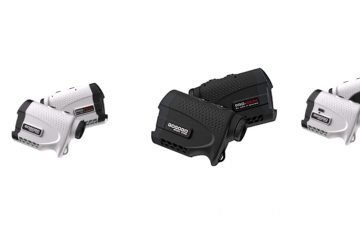A saw can be one of the most handy and useful tools when it comes to camping or even DIY-ing your next home renovation project. It is tool that can bring your object of material to any required shape like wood, plastic, or even metal sometimes. It is used by a varied group of professionals and the way they use, the type they use might vary drastically too.
You can find the most simple cutting saws to an advanced powered machineries, when it comes to saws in the market; all running down to the purpose of your saw and how you use it. Some of the working mechanism of saws used by highly technical professional will barely make sense.
Two of the most important criterion you will need to consider before purchasing one is the type of power these saws use and their working method; whether they are hand-operated or run on fuel. But, whether hand saw or power saw, one thing you really need is a humble saw that will be the most appropriate one for you.
That is why, we have listed down the 24 major types of saws in the market today, along with their pictures and uses. By reading this, you will have a fair understanding on why these saws were made and who use them, which will make it extremely easier to choose the one you need.
#1. Hand Saws
As the name suggests, hand saws aren’t electricity powered and are the ones where the users use their own generated energy to force cut into required things. Among hand saws too, there are some which are used for general cutting of materials while the others are used to cut through objects in a certain way, either in a certain pattern, or a certain shape. But, it is widely and mostly used for cutting solid wood plates, boards and perfect to construct your own key shelves in your home.
Today, while more and more handymen are turning to power tools for their convenience, less time consumption and accuracy, hand saws still lives to give that feel of pleasure when you work for something yourself, and the joy to create something on your own.
The further categorization of hand saws are as follows:
A. Cross Cut Saw
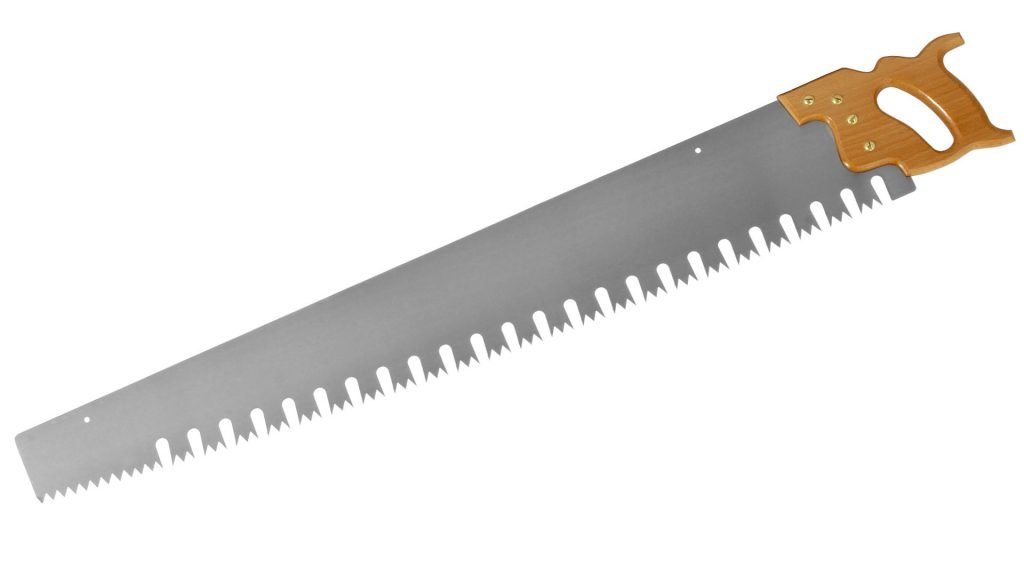
Crosscut saw is specialized in creating rough cuts on wood, for instance, trimming off branches of a tree, cutting fallen pieces of lumber, etc. It is well designed to cut across the wood grains (i.e., cuts perpendicular to the grain of the wood). These saws have large teeth and have a comparatively thick and bold blade.
This makes it very stable and sturdy when moved against rough wood. Moreover, either one or two person can use it at the same time. They are sometimes even called the lumberjack saws as the saws for two people at once have a handle on either sides. These saws have a leading edge, leaning slightly back and pre-sharpened are a certain angle to create a precise edge and a tip. This is useful, when each tooth acts as a separate saw on their own to score the wood, letting sawdust fall out with each stroke, passing by, making effective cuts.
All in all, they are very good for cutting backyard planks into your required size, and can also be handy when you go out camping; cutting out wood for fire, or even clearing out hiking trails.
B. Bow Cut Saw
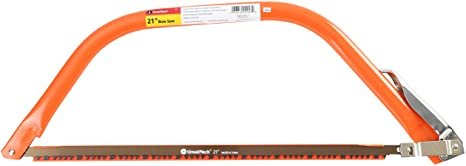
A bow cut saw is also a type of crosscut saw, but a little modern. About 8 to 12 inches long, these have a small lightweight frame. It is basically a medium-sized hand tool that is used for cutting lumbar and shearing out trees. It has a similar crosscut teeth as the former, that let sawdust fall with every passing stroke. They have a fairly long and narrow blades, which makes them very useful for thick wood sections. Curved cuts can also be made with these saws, since they can be turned even to 360 degrees, moving frames out of the way.
C. Back Saw

With a short and narrow frame, the backsaws are the saws whose blades come with further support along the upper edge. When used alongside miter box, these saws can even create miter joints at the required angles, and similar is the case for tenon box to create tenon joints. Back saws are perfect for making straight cuts and right-angled cuts. With fine teeth sets, they are mostly used for precise works. Wrapped over with a heavy strip of brass or steel over the top edge, assists a lot in keeping the blade straight at all times. Plus, the extra weight makes it convenient in cutting with less applied force.
D. Hack Saw

Hacksaws are known for their hardened teeth infused in their pliable steel back. They are designed to be more suitable for metalworking than woodworking, precisely thick metals, like bars and tubes. Lightweight, and changeable blades on requirement, they feature a plethora of cutting applications, with a tooth count of 18 to 32 inches. This spacing will let you cut through metal, wood, plastic and any other materials with ease.
E. Japanese Saw:

This saw was originally from Japan (called Nokogiri), which later became popular in North America and Europe. This blade is comparatively thin and is able to make cuts, with little effort. The Japanese sawcuts, are however, a little modified when sold in the west. The Japanese saws work on a pull mechanism, where the wood is pulled towards the body, whereas the European saws work on a push, mechanism with the wood moving away from the body. The modified saws are particularly wide and rigid. They come in three types – kataba, ryoba, and dozuki.
F. Fret Saw

The fretsaw is derived from its French etymology, the word “freter”, meaning “lattice”. And that it what this saw is exactly used for! It is a modification of a bow saw greatly designed for creating tight curves, and other extensively intricate details in your works. Equipped with about 32 teeth per inch, their fragile blades are extremely accurate. Sometimes, even called “scroll saws”, they can unfortunately not be rotated per your desire.
G. Coping Saw

Similar to the former discussed fret saw, the 6-inch long, coping saw blades are held by their metal frames, under tension. Generally used for cutting curves in solid wood, this is possible because of the narrow blades in them, having 15 to 17 teeth per inch. They are one of the most popular saws used by a lot of professional fields on the regular. They are ideal for intricate cuts, trimming, and scrolling. However, they cannot be sharpened and need to changed once the blades are dull.
H. Keyhole saw

Keyhole saw feature a dagger-like point towards the front of the blade, it’s even called a pad saw, jab saw, or drywall saw. It is generally used for making extremely small cuts. Commercially available with either a fixed or a retractable blade, they even come in paar in much popular electric jigsaw, while making small cuts. It has a round handle and a pointed blade, which can be very useful in cutting circles and similar. It is also widely used in cutting holes through concretes than wood.
I. Rip Cut Saw

When you are looking for an all-purpose woodworking saw, then this Rip cut saw might be the best one for you. It specialize in cutting with the wood grain than across the grain like the crosscut saw. Designed to efficiently carry out rougher cuts and board sizing, the tooth edge is flat and carves out material, similar to a chisel, with each passing push or pull. Rip cut saws with tapered ends are highly preferred, as they reduce friction experienced while cutting.
J. Pruning Saw:
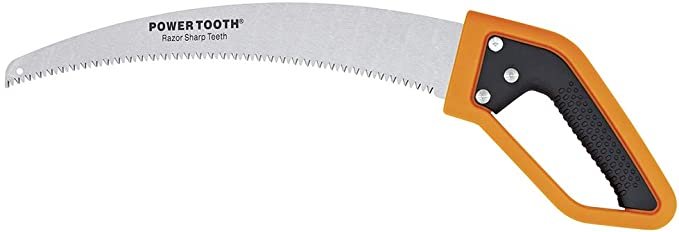
When you are having difficulty in reaching low-hanging branches or a string of dense vines through a vineyard, you will need a pruning saw. It is also frequently found attached towards the end of the poles for carrying out work on tree limbs. Having many teeth per inch, than any other comparably sized saws, pruning saws are used in managing trees, vines and shrubs, with their curved handle and curved blade, they make you work faster in hard-to-reach areas of your garden.
K. Veneer Saw

As the name suggests, these saws are designed particularly to be used in veneer works. It has a short, stout blade with a total of 13 teeth per inch pointed on both sides. Their small size, leads to a fast work done, but provide very limited range. Despite the limited range, they work quickly to demonstrate smooth results, that is, if you keep the teeth clean and free of debris.
L. Pole Saw
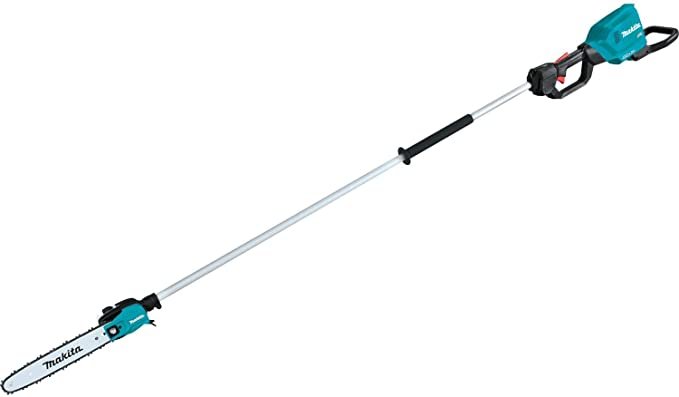
With the pole having the capability of extending up to a maximum of 16 feet depending on the specific model, these convenient beasts are a folding or pruning saws, atop a pole at the end of the day. With the blades measuring 6 to 8 inches, makes it convenient for you to reach high places for light, medium branch cutting to bush trimming. These were about the manual poles, but nowadays gas or electric poles are also popular.
#2. Power Saws
While some of them having the evolved features of a handsaws, power saws are very different to handsaws, and are not used for the same purposes too. They are usually powered by rechargeable batteries, electricity and even gas motors. They are usually divided into three different groups – Continuous Band, Reciprocating blade, and Circular Blade.
However, the drawbacks of these power saws, are that they lie on the more expensive side in comparision to the hand-saws. But, even if you buy the expensive, one will last you for a couple of years even a decade. While some of these power saws are simple in use, some are complicated and even risky to use if you aren’t well acquainted with the working of the product.
A. Chainsaw

Not the frightening horror movie or the popular shounen manga, but the popular chain saws are very popular and easily available in the market. If you have a backyard or a home-garden with a lot of trees, then you should definitely have a chainsaw with your store room. The first industrial chainsaw was developed in 1918, and they’ve been used for felling trees of all sizes, ever since. Electric motors chainsaws can be powered by either a battery or a power cord. Compared to gasoline-powered models, these battery or power run chainsaws tend to vibrate less, making your work much less tedious, much easier and fast. It is also the popular choice for these reasons.
B. Circular Saws
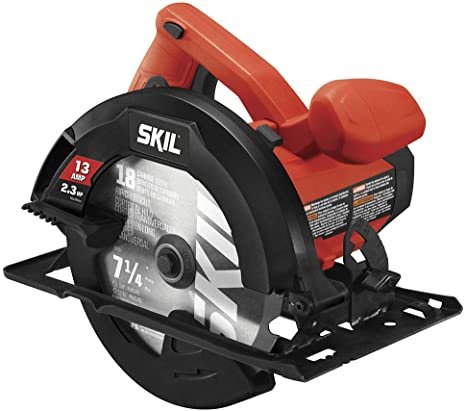
As the name suggests, these saws have circular blades that spins at a high speed, which is then directed by the user to cut through the materials. These are the most frequently used power saws, with blades covered by tooth and measuring about 7-9 inches. These are the highly portable and versatile kinds of saws and can be used for a wide range of functions. They can easily cut through metal, plastic, and masonry by just changing blades. They are very light weight, and are compatible with a lot of different blade types.
C. Miter Saws
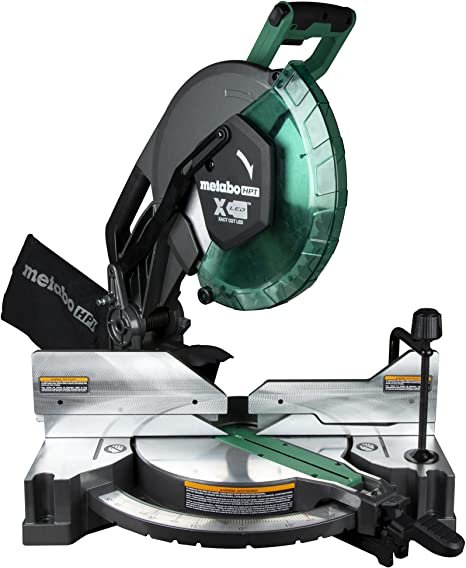
These saws, as the name suggests, are widely used in cutting miter bonds and cuts. You just have to mount the blade on an arm, which is angle adjustable to get the desired cuts made. These in return, produce compound, straight and miter cuts. These saws operate similar to the circular saws, where you have a round blade pulled downwards to cut through materials.
D. Stationary Band Saws:

Stationary band saws are generally on the safer side, as there is no kickback in these types of saws. They have a continuous blade that makes about 2-3 spins to make a cut. These blades have fine teeth in them, that makes it ideal for a wide range of materials. These saws are definitely not portable as the blades form part of a heavy table, but are great to use in a workshop. It can finely cut wood, pipes, and plastic, but is limited to cutting at just a few inches. It is also comparatively quiet in comparison to some other saw types.
E. Chop Saws:

These chopsaws are one of the largest portable circular saws, available in the market. They are available in either metal or concrete cutting version. The most recent and advanced ones have an included water line, that reduces dust when use. They have smooth toothless blades, specially designed with abrasives to cut through the desired materials.
F. Jig Saw

Having a trackable thin blade around the cutout, the jigsaws are designed to cut curves and details. Also known as “saber saw”, these are extremely versatile. It contains a downward pointing blade, guided along via an upper handle and comes in both corded and cordless varieties. They are lightweight, and are very good at creating both curved and straight cuts, in both thin and man-made boards. They are also comparatively silent in comparison to other saws, and really make a good investment for your home woodwork setup. Just increasing the speed of the blade will let you cut through thicker materials.
G. Oscillating Saw:
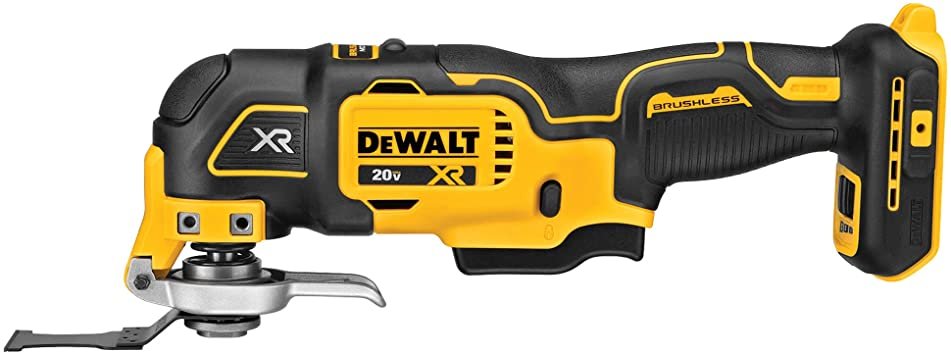
Exactly as it sounds like, it consists of an oscillating blade at its rearmost end. These blades are changeable depending on the material the saw is cutting through. Not just cutting, these saws can be used for grinding, removing grout or scraping off materials. It is lightweight and very easy to use, and is ideal for small, narrow spaces and tight corners. As convenient and perfect it is for smaller jobs, it can, however, not be used for long range cuts.
H. Rotary Saw:

These saws were initially designed for creating drywall cut-outs without a pilot hole. The characteristic rotating blade feature of this spiral cut rotary saw quickly rose to fame in fire, rescue works and even in medical fields. In homes, they’re mostly used for cleaning and accurate drywall work. Having a screwdriver-design handle with a fixed blade attached, it is mostly used for cutting through concrete walls, paneling, and other cutting activities. They have a small blade fixated to a drill-style handle, and are powered by rechargeable batteries or corded electric. They are versatile tools applicable in construction projects, home DIYs, or crafting.
I. Table Saw

Table saws are the kings in any sort of construction, remodeling, and refixing jobs. Table saws have high speed motors in order to operate the blade. Depth of the cut can be greatly modified by just modifying the length of the blade from the table, with stable guides giving you very satisfactory and accurate results. Even the most repeated cuts are accurately cut, plus, it is extremely fast too.
These blades are generally of two types available on the market; masonry blade and a metal blade. You can choose any one of them, as long as they support the motor’s rpm. You can change the cutting depth by modifying the length of the blade from the table. You can use either a masonry blade or a metal blade for cutting purposes. But, you have to make sure that the blade supports the rpm of the motor.
Table saws have a series of varieties in the market, categorized from the least to the most portable:
A. Cabinet style table saws: most powerful, highly accurate, very heavy and the most expensive.
B. Hybrid Table Saws: A little lighter and compafratively cheaper than the former.
C. Contractor Table Saws: Large in size, heavy, mounted on a base having wheels. Fairly portable with the added wheels delivering performance like the cabinet style ones.
D. Jobsite Table Saws: Lightweight yet powerful enough, portable to transport it to a jobsite, expensive for a home DIY additional tool.
E. Portable Table Saws: Extremely lightweight and portable (can be carried in one hand), not so accurate like the other table saws mentioned above, less powerful than the above ones, and budget friendly.
J. Reciprocating Saws

These types of saws feature a short, stout blade that moves back and forth in order to cut the materials. This reciprocating saws can be used to cut both wood and plastics. Plus, it can also be used to cut below the walls or joints made by woods, since this saw can cut past nails too. It is frequently used in heavy construction jobs and cutting drywall whenever much accuracy is not required. These reciprocating saws have the design of a jigsaw, with the handle being oriented in a way that allows vertical works.
K. Scroll Saws
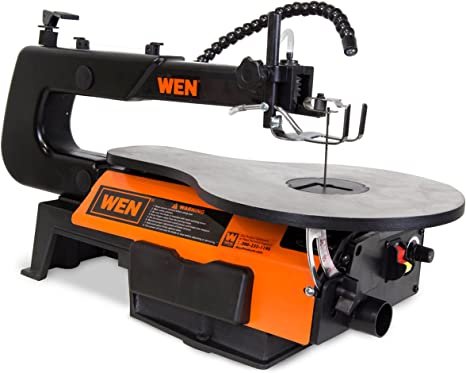
These kind of saws use a rotating feeding table and a blade connected to it’s arm. While the table rotates to create curves having sharp edges, the blade simultaneously cuts the material too. This makes it ideal for cutting precise and extensively intricate cuts in almost any materials. These saws have fine blades and a wide range of operating speeds too, making them perfect for minute, delicate works.
One of the key feature of these scroll saws are the use of a reciprocating blade instead of a continuous loop. What this basically means is that it lets you insert your scroll saw blades into a small starter hole in the material you want to cut through, giving you a lot of flexibility and ease in much intense carvings and decorative woodworking options.
L. Tile Saw
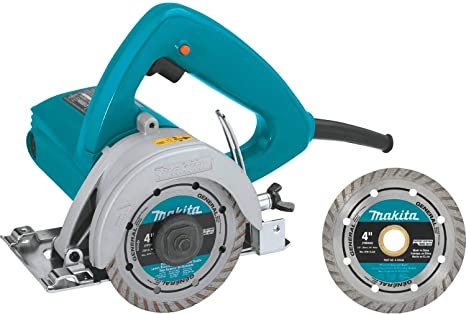
These saws are very fancy to begin with! We all know diamonds is the hardest material and can cut through anything, right? Well, these saws use that property! Tile saws use a blade that is externally coated with diamond to make cuts on hard surfaces. It also has a water cooling system to avoid the saw from overheating. It even comes with a miter, to ensure perfectly straight cuts. Integrating this water reservoir/distribution channel into a small, mounted circular saw blade, makes it very convenient to cut tile quickly and accurately to your desired measurements. Cuts made my these saws are very smooth, with clean edges making them very popular choice professional tile setters. However, their utility is limited outside this applicatory horizon.
One of the key features of this saw is that you can cut glass without breaking it. But, choosing the correct blade and compatible model with it is very crucial.
Conclusion
Throughout the years, saws, their types and their uses have increased drastically. They have become widely specific, with a particular saw based on/ perfect for a particular activity. An ideal saw for a specific work might not be the best, or might not work at all for another function completely beyond it’s reach. So, this makes it very crucial for users to first identify the function they will mostly be using their saws for.
Before purchasing any kind of saws, either professionally or either for your home-DIY project, you need to be very familiar with the use of the saws. After tallying the functional requirement, and the market service only can you reap the utmost benefit of the product, with effective working too.
We have read hundreds of reviews on online shopping sites about these products for you, and have come up with the most popular and the most-in-demand products in the market. This will limit your knowledge on saws not just in theory, but this knowledge will come in handy when you need to purchase a real one for you.
If you are still skeptical on saws, PLEASE feel free to ask us down in the comment box, and we will promise to assist you through.
Frequently Asked Questions
How many types of saws are there?
Well, there are a lot lot of saw types available in the market. But, primarily they are either hand/manual saws or power operated saws like gas, electricity saws. Other saws based on functions come under these two head topics.
What is the most frequently used saws for home DIYs?
When it comes to DIYs. hand saws are always the go to and they are extremely popular too. The mechanisms are simple and you get the feels of a real handymen. But, if you want to up your game you can opt for circular saws( interior works) and chainsaws for backyards accordingly.
Do saws cut metal? Which one cuts metal?
Saws are generally designed for cutting through wooden planks and lumber, but Hack Saws can be used to cut through metals.
What type of saws do lumbarjacks use?
Lumbarjacks use cross-cut saws. They are specialized in creating rough cuts on wood, and well designed to cut across the wood grains (i.e., cuts perpendicular to the grain of the wood), with large teeth and a comparatively thick and bold blade. Lumberjack saws are the same saws but for two people at once have a handle on either sides.



